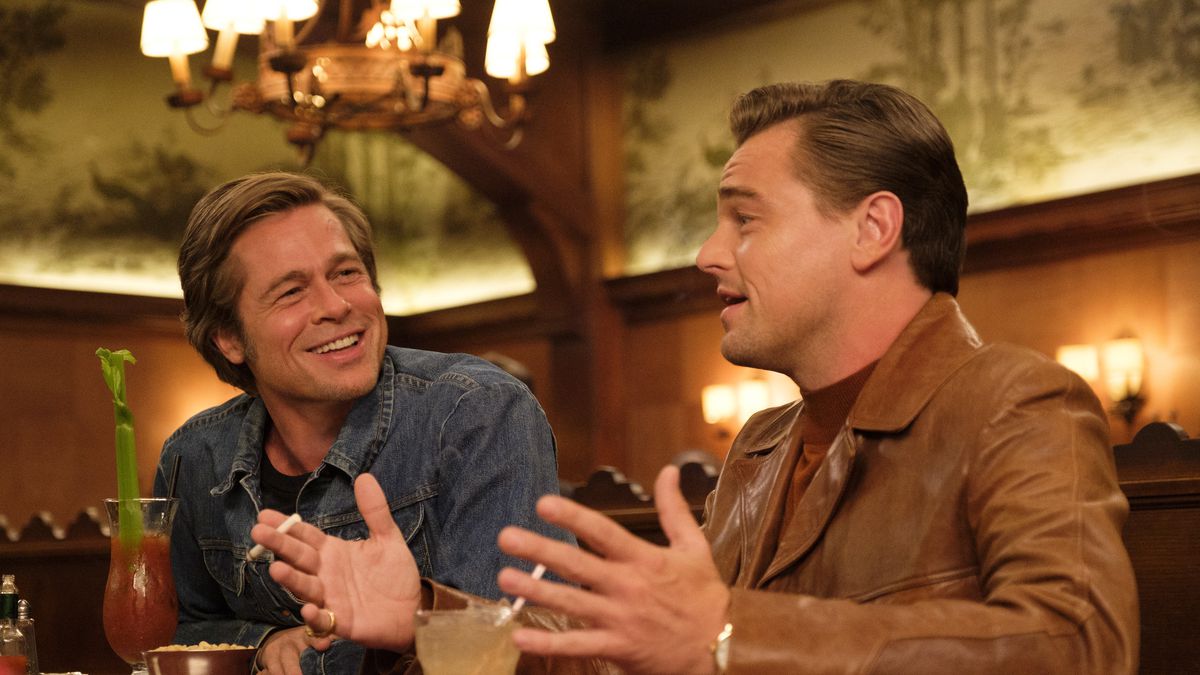Review by Reid Ramsey
Quentin Tarantino has made a career of deconstructing myths.
Death Proof is the ultimate exercise in myth making. The first half of the film establishes the ultra-macho character of Stuntman Mike (Kurt Russell) only for the second half to bring him to his humiliated, mutilated knees. Understanding the power of myth-making, Tarantino even better understands the catharsis found in their destruction, such as the revisionist history at the center of Inglorious Basterds and Django: Unchained. His newest film, Once Upon A Time… In Hollywood, is yet another exercise in retributive violence.
Unlike Inglorious Basterds, though, it’s not about who dies, it’s all about who is given life.
Rick Dalton (Leonardo DiCaprio) is a washed-up Hollywood TV actor in the late ‘60s. He spends his time ruminating over his glory days as a western bounty hunter in the hit TV show “Bounty Law.” Alongside his stunt double, Cliff Booth (Brad Pitt), he lives on movie sets trying to resurrect his earlier career. With too many DUIs to Rick’s name, Cliff doubles as his driver and also his assistant. If Rick needs something to get done, Cliff is who he goes to first.
Next door to Rick’s house is the home of Roman Polanski and Sharon Tate (Margot Robbie). Tarantino portrays the famous Sharon Tate as someone who can’t quite grab hold of her own story. Regardless of which facet of her life comes up, it’s always someone else speculating or gossiping. Whether it’s Steve McQueen (Damian Lewis) relaying her story to bystanders at a party or Rick himself envisioning becoming Tate’s and Polanski’s house guest and friend. Her life path seems dictated by the people around her which is unfortunately fitting given what the audience knows about her famous real life death in 1969.
The first time Tate really takes hold of her agency is when she goes to the movies. While running errands, the actress passes a marquee with her name on it. After reasoning with the box office attendant that she should be able to see her film for free, she sits front and center while the audience surrounding her laughs at all her lines and falls in love with her screen presence. It’s obvious and it’s gratifying, but above all, it’s a lovely moment for Sharon Tate to be nothing more than a person, someone she hasn’t been allowed to be in decades.
Although the depiction of Tate has been a constantly divisive talking point — mostly due to her lack of dialogue — in the end it is a lovely, humanist tribute.
A major function of Once Upon A Time… In Hollywood is to demystify the Manson Family — the infamous radical cult living in Hollywood in the ‘60s who killed Tate and many others in August 1969. Pitt’s Cliff is the character to bump up against the family the most. When wooed into picking up Pussycat (Margaret Qualley) as a hitchhiker, he discovers that Spahn Movie Ranch, where he used to work alongside Rick, has been overtaken by the “family.” Skeptical of the legality of them living there, Cliff seeks out the old owner of the ranch whom he used to know. One of the most tense scenes in the movie eventually diffuses as Tarantino attempts to demystify his own tendencies: regardless of the expectation of explosive violence in a film by the man who made Reservoir Dogs and The Hateful Eight, he maintains in complete control.
In Hollywood, Tarantino takes power away from the Manson Family by positioning them as bumbling, hate-filled, brainwashed people. Although Charles Manson is barely seen on screen, it’s clear he acts as puppet master. From behind the scenes, he calls the shots almost as a sadistic film director instructing his actors to hit their marks.
While his newest film doesn’t stray from his usual strain of revisionism, Tarantino shows something in Hollywood he’s only hinted at before: an intense need to meander. Whereas he’s often indulgent when depicting violence; here, the director depicts late-Golden Age Hollywood with an indulgent bloat that could test the patience of any cinephile. With a need to revel in the, uh, boring world of TV westerns, the movie spends so much time on set with Dalton. Tarantino also clearly feels a duty to teach his audience facts about cinema from this time period, which includes a crash course in Spaghetti Westerns and one character reiterating that he’d watched Rick’s films “on 35 millimeter film,” which is the most unintentionally funny line in the movie.
The meandering is not nearly as efficient as say, the Coen Brothers Hail, Caesar! which tackled similar subject matter, yet there’s something inherently nostalgic about sitting back in a theater and watching people wander through their lives, in truncated real time. Yes, even if this nostalgia is based in a very male-fantasy movie like this.
By the end of Once Upon A Time… In Hollywood, it’s clear that Tarantino had two clear objectives: to entertain and to humanize Sharon Tate. The result is his most moving film — maybe his only moving film. There’s something special about a movie which gives characters’ life, and it’s even better when one gives a hopeless actor like Rick a reason to live.

